Hervé, Alfred, Count de la Monniere (McKechnie Section 1)
See also Section Six
The name of Alfred Hervé, the silhouette artist, was identified among the members of the Hervé family by Jackson (Dictionary). For an account of the Hervé family and its relationships, see Appendix Three.
Records at Somerset House examined by Mr Percy Higgs show that two men named Alfred Hervé died between 1837 and 1890. When the dates of these deaths are related to 1841 census lists, it appears that the elder Alfred Hervé died in 1861 aged eighty-one, and the younger Alfred Hervé died in 1879 aged sixty-six. The latter, then, must have been born in C. 1812.
Many members of the Hervé family were artists, and as the Alfred Hervé in whom we are interested as a silhouette artist does not appear to have exhibited at the Royal Academy until 1841, and did not appear in any London Directory entries until 1839, it is reasonable to suppose that the younger Alfred Hervé was the silhouette artist. It is also reasonable to suppose that the two men were father and son. As there is no evidence that the elder Alfred Hervé was an artist, the silhouette artist is referred to here simply as Alfred Hervé, not as Alfred Hervé II.
Alfred Hervé's father was, it would seem, of the same generation as the silhouette artist Charles Hervé II (q.v.), and it is likely that the two men were brothers.
I own a plain black silhouette, presumably early work, by Alfred Hervé, cut apparently in c. 1837.
445
Presumably, therefore, he began to cut silhouettes under his own name when he was about twenty-five, having, perhaps, previously assisted other members of his family in the same field. The stencil on this particular example appears to give an address at 143 Strand.
449
Hervé sent in three 'portraits' to the Royal Academy from 145 Strand, London, 1841-43. Two of the sitters were Thomas Wilkins and J. D. Wilkinson (see Section Six). Directory entries show that Alfred Hervé either lived or worked at this address for many years from 1839 until 1850. Thereafter, Hervé is listed at 158 Strand from 1851 until 1859, and at 260 Oxford Street from 1860 until 1863. Mr R. Kilner, however, owns a silhouette, marked with the name of A. Hervé and dated May 1847, which gives an address at 199 Oxford Street. Many members of the Hervé family lived in the neighbourhood of Stockwell and Clapham, and Alfred Hervé may have retired there until his death in 1879.
448
Alfred Hervé's activities were intermittently connected with those of his probable uncle Charles Hervé II. In the entry on the latter I have quoted a handbill, headed 'A Warning Voice!', which gives the 145 Strand address as 'at Somerset Hall'. (The reference to 'Somerset Hall' is mysterious; Mr Higgs has found no explanation of it in contemporary publications. The address was only a few doors from Somerset House; perhaps 'Somerset Hall' was a fanciful invention of the Hervés derived from this fact.) A similar handbill, doubtless issued by one of the Hervés, is quoted in the entry on the City Portrait Gallery (q.v.). There is evidence that Charles Hervé II also used the 145 Strand address at some time (see the entry on him). Neither Alfred nor Charles Hervé are recorded as tenants at this address. During the 1840s the chief tenant was William Harvey, an umbrella maker. (Or could this name be an Anglicized version of Hervé?) During the 1850s, when the directory entries show that Alfred Hervé was at 158 Strand, the chief tenant of No. 145 was a lamp maker. A coffee room and a boot-maker's establishment are listed at 260 Oxford Street for the years 1860-63. There is no indication that Alfred Hervé was ever a householder at any of the addresses mentioned above.
It is possible that in his youth Hervé was one of the assistants in the Prosopographus (q.v.) concern.
Authentic silhouettes by Hervé are dated and marked with a stencil showing the name 'Mr. A. Hervé'. They range in date from c. 1837 until May 1847. Since Hervé was involved with one, and possibly more, of Charles Hervé II enterprises, he may have used his own stencils only intermittently.
The illustrated portrait of Madame Tussaud deserves special mention. It is so much like that in the Tussaud family group by Joseph Tussaud (see Section Two) that one cannot tell whether Alfred Hervé retook this figure from Joseph Tussaud's group (the more likely possibility), or whether Tussaud used Hervé's figure as a basis for a figure in his own group. This profile bears the inscription 'By Alfred Hervé, Count de la Monniére'. No doubt Hervé signed himself thus for the benefit of the Tussaud family, for whom the French title would have some meaning. As Charles Hervé II also is known to have painted a miniature of Joseph Tussaud, it seems that there was a friendship between these two French-speaking families. Otherwise, the style 'de la Monniére' seems to have been used only by Francis and Rosa Hervé.
446
Alfred William Hervé (c. 1848-1867) was probably Alfred Hervé's son.
Since Hervé painted portrait miniatures in colour, it is to be expected that he should have painted his cut silhouettes in a variety of styles.
One plain black cut profile is illustrated; this is probably an early example of the artist's work.
445
Hervé seems more often to have painted in black, or gum arabic mixed with black, on dark-grey paper. This technique is very similar to that of Charles Hervé II, and, unless an example is signed or otherwise identifiable, it might be difficult to attribute it to one or other of these two artists. Gold has been used with considerable success on the illustrated full-length profile of an officer; this portrait might almost be said to be painted in part colour, since the gloves are shown in white and grey tints.
447
In the true Hervé family style is the bust-length profile in Mr Kilner's collection; taken in 1847, it is painted in black either on dark-grey paper or on white paper painted in dark-grey body colour.
448
I have seen full-length profiles painted in gold on black. Jackson, on the other hand, recorded a miniature-size portrait in a locket. Hervé, therefore, was competent to produce profiles of any size, and in several styles. Early examples are framed in papier mâché; later work, including full-length examples, in rosewood, with gilt surrounds.
One would expect to see costume of c. 1837-47 shown on Hervé's work, most of which seems to have been executed during the period 1838-c. 1843.
The available evidence suggests that painting miniatures and cutting and painting silhouettes occupied only ten years of Hervé's life; he may have pursued other occupations at other periods. He does not seem to have used printed trade labels, but stencils or inscriptions written in a cursive hand. The illustrated stencil (referred to above) appears to give the address 143 Strand, London. A similar stencil is shown on the bottom right-hand corner of the full-length profile of the officer (also referred to above); this appears to read '145 Strand'. As this is the address given in directory entries, more examples bearing this address probably exist.
Ills. 445-449
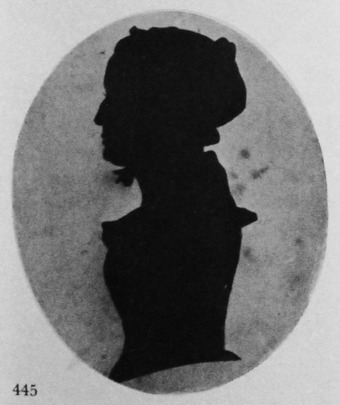
Unknown woman
Cut silhouette
? c. 1837
3½ x 2¾in./90 x 70mm.
Stencil
Frame: papier mâché
Author’s collection
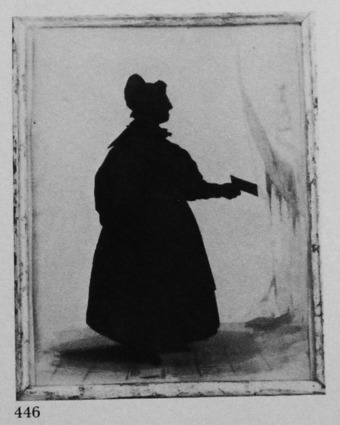
Madame Tussaud
Cut silhouette, painted in black against dark grey
c. 1838
Frame: maple
Inscribed on the reverse, ‘By A. Hervé, Count de la Monnière’. Cf. the figure of Madame Tussaud in the group silhouette of the Tussaud family by Joseph Tussaud (939).
By courtesy of Mr Angelo Tussaud
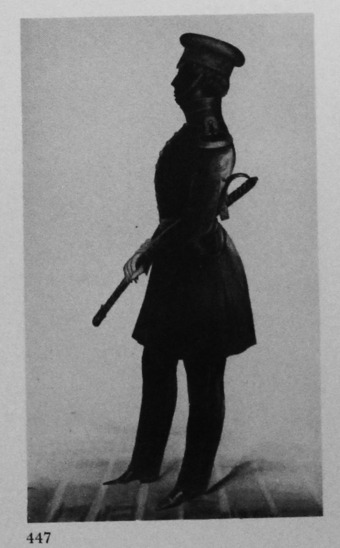
Officer of the 53rd Foot (Shropshire Light Infantry)
Cut silhouette, painted in bronze tints, white and grey
c. 1841
The sitter is wearing undress uniform; ‘wing’ (unfringed) epaulettes were worn on the frock-coat of undress uniform from c. 1834. The gloves are painted in white, shaded with grey-
From the collection of the late J. C. Woodiwiss
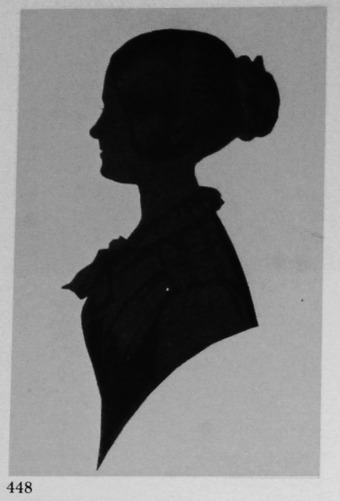
Unknown woman
Cut silhouette, painted in black either on dark-grey paper or on white paper painted in dark-grey body colour
May 1847
4½ x 2½in./115 x 64mm.
Frame: rosewood, with gilt surround
Taken at 199 Oxford Street, London.
R. Kilner collection
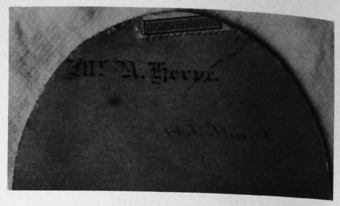
Stencil of Alfred Hervé, which appears to read ‘143, Strand’.
Author’s collection
